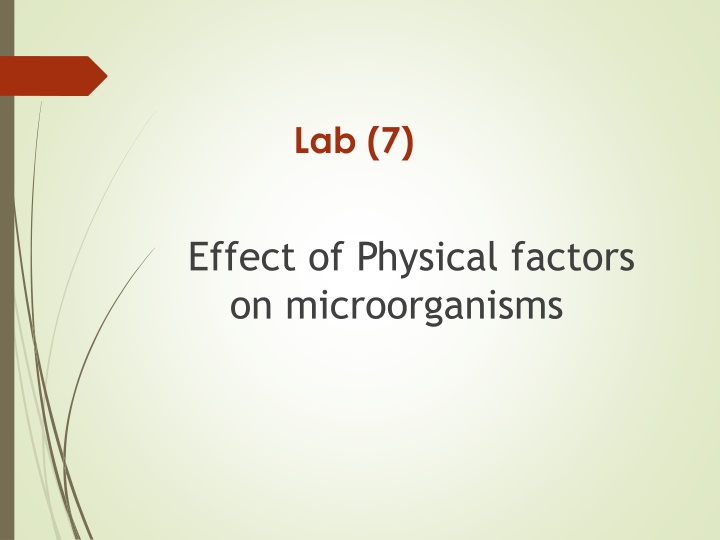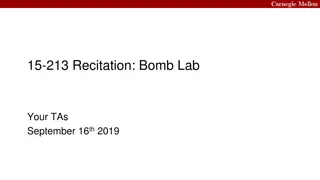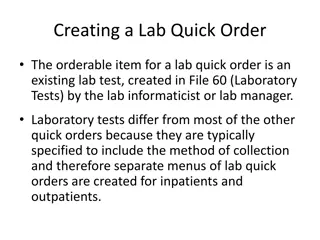
Impact of Physical Factors on Microorganism Growth
Explore the influence of physical factors like temperature, pH, osmotic pressure, and radiation on microorganisms' growth and survival. Learn about the different temperature classifications and pH considerations for bacterial growth.
Download Presentation

Please find below an Image/Link to download the presentation.
The content on the website is provided AS IS for your information and personal use only. It may not be sold, licensed, or shared on other websites without obtaining consent from the author. If you encounter any issues during the download, it is possible that the publisher has removed the file from their server.
You are allowed to download the files provided on this website for personal or commercial use, subject to the condition that they are used lawfully. All files are the property of their respective owners.
The content on the website is provided AS IS for your information and personal use only. It may not be sold, licensed, or shared on other websites without obtaining consent from the author.
E N D
Presentation Transcript
Lab (7) Effect of Physical factors on microorganisms
G row th An orderly increase in the quantity of all the cellular constituents. The growth of microorganisms is influenced by various physical and chemical factors of their environment. Physical factors- Temperature, pressure,hydrostaticpressureandradiation. Chemical factors- Oxygen, phosphorus, sulfur,etc. pH, osmotic carbon, nitrogen,
Physical factors influencing the growth of microorganisms: pH Osmotic Pressure Temperature Radiation
Temperature - Temperature is the most important factor that determines the rate of growth, multiplication, survival,anddeathofalllivingorganisms. - High temperatures damage microbes by denaturing enzymes, transport carriers,and other proteins. - Microbial membrane temperature extremes. - At very low temperatures membranes also solidify and enzymes also do not function properly. are disrupted by
Types of temperature Minimum growthtemperature Optimum growth temperature Maximum growthtemperature
1- The Minimum growth temperature The lowest temperature at which organisms grow is the minimum growth temperature. 2. Optimum growth temperature The temperature at which the most rapid rate of multiplication occurs. 3. Maximum growth temperature Thehighest temperatureatwhichgrowthoccurs. A temperature only frequently kills the microorganisms by inactivating criticalenzymes. slightly above this point
Classification of bacteria accordingto growth temperature
pH - pH refers to negative logarithm of hydrogen ion concentration. - Microbial growth is strongly affected by the pH ofthe medium. - Drastic variations in cytoplasmic pH: disrupt the plasma membrane or inhibit the activity of enzymes and membrane transport proteins.
Acidophiles: Grow between pH0 and 5.5. Examples:Ferroplasma,Thiobacillusthioxidans,Sulfolobus acidocaldarius, etc. Alkalophiles:GrowbetweenpHrangeof7.5to14. Examples:Thermococcus alcaliphilus,etc. Neutrophiles :GrowbetweenpH5.5to8.0 Examples: Lactobacillus Pseudomonas aerunginosa,etc. acidophillus, Bacteria prefer media of pH near neutrality, and usually cannottoleratepHvaluesmuchbelow4-5.
Osmotic pressure - is the minimum pressure which applied to a solution to prevent the inward flow of wateracrossaSPM. needs to be - is the force developed when two solutions of different solute concentrations are separated by a membrane that is permeable only to the solvent.
Types of solution: 1-Isotonic2-Hypertonic3-Hypotonic
Classification of bacteriaaccording to osmoticpressure Osmotolerant are those microorganisms which can growatrelativelyhighsaltconcentration. Examples:Aeromonas spp., Staphylococcus spp, etc. 2. Halophiles- Grow in the presence of salt at conc. Above 0.2 to0.6. Examples: Halobacterium halobium






















